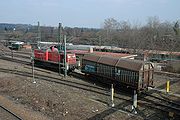
Switching and terminal railroad
Encyclopedia

Rail yard
A rail yard, or railroad yard, is a complex series of railroad tracks for storing, sorting, or loading/unloading, railroad cars and/or locomotives. Railroad yards have many tracks in parallel for keeping rolling stock stored off the mainline, so that they do not obstruct the flow of traffic....
. It generally consists of making up and breaking up trains, storing and classifying cars, serving industries within yard limits, and other related purposes. These movements are made at slow speed under special yard rules.
Facilities
A terminal facility can include a unionUnion station
A union station is the term used for a train station where tracks and facilities are shared by two or more railway companies, allowing passengers to connect conveniently between them...
freight station, train ferry
Train ferry
A train ferry is a ship designed to carry railway vehicles. Typically, one level of the ship is fitted with railway tracks, and the vessel has a door at the front and/or rear to give access to the wharves. In the United States, train ferries are sometimes referred to as "car ferries", as...
, or bridge. Its purpose is to connect larger carriers to other modes of transport
Intermodal freight transport
Intermodal freight transport involves the transportation of freight in an intermodal container or vehicle, using multiple modes of transportation , without any handling of the freight itself when changing modes. The method reduces cargo handling, and so improves security, reduces damages and...
or other carriers.
Ownership
These companies may be jointly ownedJoint railway
A joint railway is a railway operating under the control of more than one railway company: those companies very often supplying the traction over the railway.-United Kingdom:There are many examples of joint railway working in the United Kingdom...
by several major carriers; examples include the Belt Railway of Chicago
Belt Railway of Chicago
The Belt Railway of Chicago , headquartered in Chicago, is the largest switching terminal railroad in the United States. It is co-owned by six Class I railroads — BNSF Railway, Canadian National Railway, Canadian Pacific Railway, CSX Transportation, Norfolk Southern Railway, and Union...
, Terminal Railroad Association of St. Louis
Terminal Railroad Association of St. Louis
The Terminal Railroad Association of St. Louis is a terminal railroad owned by railroads in St. Louis, Missouri which handles traffic through its metropolitan area.-Components:It was founded in 1889 in a deal orchestrated by Jay Gould by:...
, and Conrail Shared Assets Operations
Conrail Shared Assets Operations
Conrail Shared Assets Operations is an American railroad company. It operates three networks—the North Jersey, South Jersey/Philadelphia, and Detroit Shared Assets Areas, where it serves as a local carrier and switching company for CSX Transportation and the Norfolk Southern Railway...
.
Incentives
The Internal Revenue ServiceInternal Revenue Service
The Internal Revenue Service is the revenue service of the United States federal government. The agency is a bureau of the Department of the Treasury, and is under the immediate direction of the Commissioner of Internal Revenue...
provides tax incentive
Tax incentive
A tax incentive is an aspect of the tax code designed to incentivize, or encourage, a certain type of behavior. This may be accomplished through means including tax holidays, tax deductions, or tax abatements...
s for this type of company. They may also be created when a larger railroad abandons an unprofitable line, and a short-line railroad takes over operations to connect shippers to the larger company.

